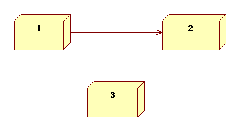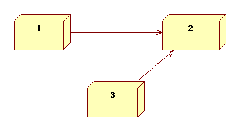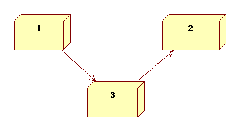跟我学数据结构:(3)单向链表
摘要:
本文通过示例,演示了用C++实现数据结构的单向链表。
读者对象:
对C++有一定基础的同学。
技术要点:
C++数据抽象
构造函数
析构函数
运算符重载
编码规范初步
指针
友元
声明
本文中相关数据结构及代码是为教学需要而设计,不适用于商业产品。
链表的引入
我们在上节课“数组”是,讲到了对数据的遍历、查找、插入和删除。当我们在对数组进行插入或删除操作的时候,会引起操作点之后的元素整体移动,大量的数据移动(内存复制)会产生能下降的问题。链表正是避免了这一问题。
注:本系列教程以代码,示例演示为主,关于链表的数学定义请参考其它书籍。
链表的设计
链表一般提供了以下操作:
1) 创建链表 creatList()
2) 在指定节点后面插入一个新的节点 insertAfter()
3) 删除指定的值的节点 remove()
4) 遍历所有节点 operator<<()
5) 销毁所有链表
插入节点的操作示意图
操作前
操作过程
(1)
(2)
(3)
删除节点的操作示意图
操作前
操作步骤
(1)
(2)
代码及运行结果
//file: main.cpp //desc: this program illustrate how to use linked-list //date: 2009-6-1 //author: Stone Jiang #include using namespace std; typedef int Data_T; class Node_T { public: // [1] explicit Node_T(Data_T x); Node_T(); ~Node_T(); public: // public interface void next(Node_T* next); Node_T* next( void); Data_T value(); // [2] friend ostream& operator << (ostream& os, Node_T* header); private: Data_T value_; Node_T* next_; }; Node_T::Node_T() :value_(0),next_(0) { //cout << " create " << this->value_ << endl; } Node_T::Node_T(Data_T x) :value_(x),next_(0) { //cout << " create " << this->value_ << endl; } Data_T Node_T::value() { return this->value_; } Node_T::~Node_T() { //cout << " destroy " << this->value_ << endl; } void Node_T::next(Node_T* next) { this->next_ = next; } Node_T* Node_T::next() { return this->next_; } //= create List Node_T* createList(); //= Insert a new node @ after @ in the list 0 // success return 0,otherwise return non-zero int insertAfter(Node_T* header,Data_T x,Node_T* node); //= Remove @ from list int remove(Node_T* header,Data_T x); //= destroyList int destroyList(Node_T* header); ostream& operator << (ostream& os, Node_T* header); int main( int, char**) { Node_T* header = createList(); cout << header; Node_T* one = new Node_T(1); insertAfter(header,0,one); cout << header; Node_T* three = new Node_T(3); insertAfter(header,1,three); cout << header; Node_T* two = new Node_T(2); insertAfter(header,1,two); cout << header; Node_T* five = new Node_T(5); insertAfter(header,3,five); cout << header; cout << " remove :"< return 0; } Node_T* createList() { Node_T* header = new Node_T(0); return header; } int insertAfter(Node_T* header,Data_T x,Node_T* node) { int result = -1; if (header) { Node_T* current = header; if (current->value() == x || current->next() == 0) { // [1] node->next(current->next()); current->next(node); result = 0; } else { return insertAfter(current->next(),x,node); } } return result; } int remove(Node_T* header,Data_T x) { int result = -1; if (header) { Node_T* prev = header; Node_T* current = header->next(); if (current->value() == x) { prev->next(current->next()); delete current; current = 0; result = 0; } else { return remove(current,x); } } return result; } int destroyList(Node_T* header) { Node_T* current = header; while (current) { Node_T* temp = current; current = current->next(); delete temp; temp = 0; } return 0; } ostream& operator << (ostream& os, Node_T* header) { if (header) { Node_T* current = header; os << " ( " << current->value() << " ) ---> "; return os << current->next(); } else { cout << " ( END )" << endl; } return os; }
( 0 ) ---> ( END ) ( 0 ) ---> ( 1 ) ---> ( END ) ( 0 ) ---> ( 1 ) ---> ( 3 ) ---> ( END ) ( 0 ) ---> ( 1 ) ---> ( 2 ) ---> ( 3 ) ---> ( END ) ( 0 ) ---> ( 1 ) ---> ( 2 ) ---> ( 3 ) ---> ( 5 ) ---> ( END ) remove : ( 0 ) ---> ( 1 ) ---> ( 2 ) ---> ( 5 ) ---> ( END ) ( 0 ) ---> ( 2 ) ---> ( 5 ) ---> ( END )
代码说明
(1) 部分收入C++面向对象的特性。示例中演示了构造函数,重载了构造函数。
(2) 代码中使用了递归算法。由于链表的定义可以通过递归来定义,并且在之后的课程中我们将广泛的使用递归算法,所以,我们在本代码中使用了递归算法。
您能找出我们在哪些地方用到了递归吗?
(3) 重载 << 函数。 为了方便对链表的遍历和输入,我们重载了< <函数。同学们是否可以从main()中看到,使用了> <<()之后,代码变简洁了?
(4)
埋个伏笔
我们并没有对链表作完合的面向对象封装,所以在使用代码的时候,额外的增加了对链表是否有效作了判断。另外,为了使代码简洁,我们并对函数调用的返回值作检查。在创建和删除节点的时候,我们都使用了动态内存分配。如果我们插入从栈上的临时节点到链表中,将收内存问题。这些,我们都将在后续的课程中为大家解决。




























 218
218

 被折叠的 条评论
为什么被折叠?
被折叠的 条评论
为什么被折叠?








